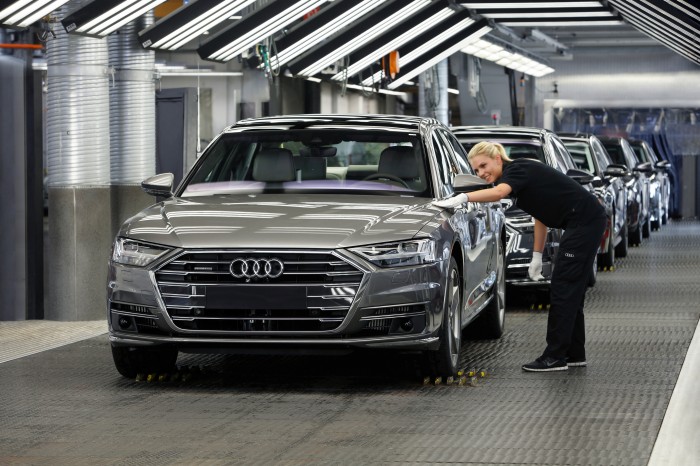Audi’s New A8 May Drive Itself, But Owners Should Proceed with Caution

Audi’s new luxury A8 sedan is claimed to drive itself in traffic jams at speeds of up to 37 miles per hour. People driving the car, however, will be well-served to keep their wits close at hand.
The new vehicle is loaded with radar, cameras, ultrasound sensors, and a laser scanner. In fact, Audi claims that it’s the first production car to use lasers, the notional gold standard for driverless vehicles, to sense its surroundings. At the time of writing Audi hadn’t responded to a request for details about the sensors. Still, it sets the company apart from Tesla, which has received criticism for the fact that its Autopilot autonomy system only uses radar and cameras, which are less accurate.
Last year, a Tesla was involved in a fatal crash when a driver used Autopilot and failed to take control of the vehicle despite numerous warnings—touching the steering wheel for only 25 seconds during 37 minutes of driving. The car collided with a semi truck that pulled out across the highway, which its radar and camera sensors failed to spot.
That laser sensor on Audi’s new car will help avoid that situation, and combined with the other technology will provide data for what Audi calls a traffic-jam pilot. This is an autonomy function, activated by pressing a button labelled “AI,” that manages starting, accelerating, steering, and braking at speeds of up to 37 miles per hour in traffic on highways where a physical barrier separates opposing traffic flow. Audi suggests that the feature can allow drivers to “take their hands off the steering wheel permanently and, depending on the national laws, focus on a different activity that is supported by the car, such as watching the on-board TV.”
That startling suggestion will prove divisive in the world of autonomous-vehicle development, where there’s somewhat of a schism in design philosophy. Some firms, like Audi and Tesla, are already pushing out autonomy features that can handle highway driving but require the driver to take over if the car can’t handle the conditions. Others, including Ford, Waymo, and Uber, are playing a longer game and trying to build vehicles that require no human intervention.
It’s not clear which is correct. Proponents of semi-autonomous vehicles say that even a first wave of automation will increase the safety of cars and reduce the number of crashes on our roads. But Waymo (50 Smartest Companies 2017) says its research shows that drivers become dangerously complacent in semi-autonomous cars. Some experts have warned that such vehicles could increase the number of distracted-driving deaths in the near future.
For its part, Audi has clearly put a lot of effort into preparing the vehicle in case a driver’s attention does wander. From Wired’s coverage of the car launch:
The A8 watches its human with a facial-recognition camera in the instrument cluster; its steering wheel knows when it’s being touched. If the car determines it needs help or senses that the human is not paying attention, it pesters them with visual and audio cues. If those don’t work, the car tightens the seatbelt and pumps the brakes. Still no response? The car will turn on its flashers, slow to a stop, and unlock the doors.
That’s great and all, but it doesn’t account for sudden problems that might happen too quickly for the new car to have the driver take over. It’s unpredictable edge cases—such as a person suddenly stepping onto a freeway—that present the largest challenges for autonomous vehicles. However rare they might be on highways, those kinds of problems are the ones that have convinced the likes of Waymo and Uber to push for full autonomy from the get-go.
Truth is, sensors and algorithms aren’t yet up to the task of dealing with everything that life on the road can throw at cars. Owners of Audi’s new A8 should at least bear that in mind when they summon AI to take control of the wheel.
(Read more: Audi, Wired, “Lazy Humans Shaped Google’s New Autonomous Car,” “Semi-Autonomous Cars Could Increase Distracted-Driving Deaths,” “Self-Driving Cars’ Spinning-Laser Problem”)
Keep Reading
Most Popular
Large language models can do jaw-dropping things. But nobody knows exactly why.
And that's a problem. Figuring it out is one of the biggest scientific puzzles of our time and a crucial step towards controlling more powerful future models.
How scientists traced a mysterious covid case back to six toilets
When wastewater surveillance turns into a hunt for a single infected individual, the ethics get tricky.
The problem with plug-in hybrids? Their drivers.
Plug-in hybrids are often sold as a transition to EVs, but new data from Europe shows we’re still underestimating the emissions they produce.
Google DeepMind’s new generative model makes Super Mario–like games from scratch
Genie learns how to control games by watching hours and hours of video. It could help train next-gen robots too.
Stay connected
Get the latest updates from
MIT Technology Review
Discover special offers, top stories, upcoming events, and more.